 |
Focus features two in-depth reviews each month of fine art, architecture and design exhibitions and events at art museums, galleries and alternative spaces around Japan. The contributors are non-Japanese art critics living in Japan. |
|
|
 |
 |
 |
Poetry in Motion at 21_21 Design Sight
Susan Rogers Chikuba |
 |
It may be too hot out to fully appreciate the park-like setting of Midtown Garden, but the Motion Science show inside at 21_21 Design Sight offers exhibits that are fun for the whole family. Play with Droplets by Atelier Omoya is a study of surface tension. Left photo by Susan Rogers Chikuba; right photo courtesy of 21_21 Design Sight |
Filmmaker Seiichi Hishikawa has a reputation for soft-mannered, open-ended commercial works that are low on glitz and high on cross-generational appeal, a style epitomized in "Xylophone," the 2011 cyber film he directed for NTT Docomo that went viral and garnered two golds and one silver at Cannes Lions. That same playful, craft-oriented spirit drives the Motion Science exhibition now showing at 21_21 Design Sight in Tokyo through September 27.
Hishikawa says the conceptual germ for the show emerged two years ago, when he participated in a teachers' forum on the dwindling number of hours allotted to art and music classes in primary and secondary school. "Those hours are being earmarked instead for English and digital studies, which are certainly needed. But even so, that doesn't justify sacrificing the arts. There has to be another approach." When the Midtown museum gave him carte blanche to launch a summertime exhibition this year as creative director, he knew straightaway that it was an opportunity to revisit the issue, and so he set out to showcase the imaginative, artistic impulse that underlies all science. "Nothing happens in a black box. Whether analog or digital, it's the creative and collaborative process of design that ultimately links technology with innovation, and that's what we'd like to show here," he explains.
|
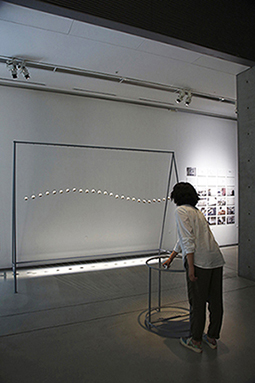 |
|
|
|
Project Motion / Cycle by students of Kano Lab in the Creative Design Course at Tohoku Institute of Technology employs an ingenious slider-crank mechanism fashioned of string to invite museumgoers to play with the mathematical curve of a sine wave. The story of how the project came to be, shown in the exhibition's "making of" documentary, sweetly captures the students' honest eagerness. Photo courtesy of 21_21 Design Sight |
Hishikawa's Motion Science is a sprawling hall's worth of gizmos and gadgets and installations that demonstrate such mechanisms as airflow, surface tension, optics, fluid dynamics, periodic motion, slider-crank design, and rotoscoping. Working from the premise that today's students -- tomorrow's engineers and artists -- have fewer opportunities to futz around with mentors in woodshop or the art room, he conceived the exhibition to have the feel of an open lab, where visitors can experience not only how things work but also view the behind-the-scenes "making of" process on film. Registration has already closed for the hands-on weekend workshops on zoetropes and motion machines, but with nearly two dozen presentations on display in the show proper, there are plenty of ideas here for kids who haven't yet settled on a theme for their summer research assignment, and adults won't be bored either.
Even the bilingual captions, set out on punchboard with a sampling of the tools and materials used in production, are presented in a way that emphasizes craft. Post-it notes handwritten by Hishikawa tell less of the science involved and more of the fun behind each project's idea. Mitsuyoshi Miyazaki of Hagi Studio, who assisted with the show's spatial design and presentation, explains that the aim was "to keep the commentary quick and inspirational, inviting viewers to approach the works flexibly, in their own way."
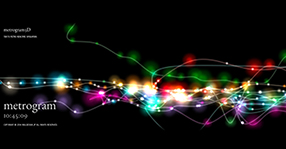 |
|
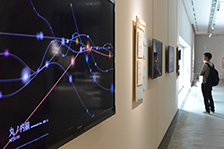 |
|
|
|
Hiroshi Koi's metrogram 3D is one expression of the artist's interest in how any given network -- in this case mass transit -- can be communicated visually. Left photo courtesy of 21_21 Design Sight; right photo by Susan Rogers Chikuba |
In all, 21 artist units, average age 30 or so, created exhibits that physically move or otherwise express movement using familiar, everyday materials and tools. One work that takes this mandate literally is metrogram 3D by Hiroshi Koi, a specialist in algorithm-based media art and data visualization. His digitized map, which condenses the train departures and arrivals of the entire Tokyo Metro system over a single day into a few short minutes, could be mistaken for a stylized computer graphics animation of rotating celestial pulsars -- but it's quite simply the result of data he inputted, by hand, from the pocket-sized timetable printouts provided at station windows.
 |
|
 |
|
|
|
Mari Numakura's Layer of Air shows how a moving screen of tulle plays with light and shadow to transform shapes like circles and triangles. Photos by Susan Rogers Chikuba |
Layer of Air, a lovely work by Mari Numakura, was inspired by the play of sunlight across the curtains of the artist's hotel room one morning in Barcelona, and became her submission for the 63rd Graduation Works Exhibitions at Tokyo University of the Arts earlier this year. Simple geometric figures -- a line, a triangle, circles and dots -- are projected in white against a far wall. In between the light source and wall hangs a translucent curtain of tulle, eight meters high and nearly five meters across. Soft currents emitted by three floor fans blow the lightly weighted fabric, so that the shapes projected through it twist and morph into a mesmerizing array of endless organic forms. Tucked away in a quiet corner of the hall and one of the last works encountered along the route, the installation includes original music by Yoshiki Masuda that complements the lilting optical play, the whole serving to soothe the senses after a cluster of more interactive exhibits.
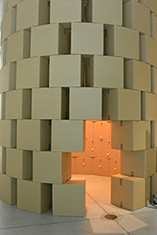 |
|
 |
|
|
|
The self-taught Swiss artist Zimoun uses industrial materials and found objects to build structural works that combine spatial and sonic elements, as in 124 prepared dc-motors, cotton balls, cardboard boxes 53x53x53 cm, created for the 21_21 show. Photos by Susan Rogers Chikuba |
 |
|
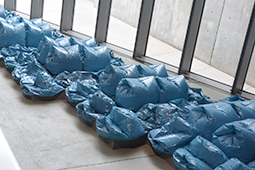 |
|
|
|
Artist Nils Völker employs basic computer programs to blend technology and art. His Sixty Eight places rotating fan blades within as many garbage bags. When the fans move counterclockwise, air is drawn in; clockwise, air is blown out. Photos by Susan Rogers Chikuba |
There are presentations by non-Japanese exhibitors as well. Bern-based Zimoun, an artist known for his ambient "sound sculptures," and Nils Völker of Berlin have contributed works that express periodic motion and airflow control, respectively. Strikingly set in the center of the hall, Zimoun's work is a silo-like tower of 124 cardboard boxes. Inside, cotton balls hung from different lengths of wire and driven by DC motors beat incessantly against the walls of the empty boxes; the effect is somewhat like being inside a waterfall. Völker's installation uses electronic signals to control and alternate the direction of spinning fan blades, turning 68 plastic garbage bags into a pulmonary mass of breathing objects that are oddly entrancing to watch.
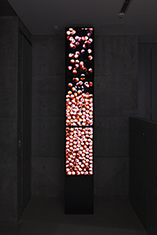 |
|
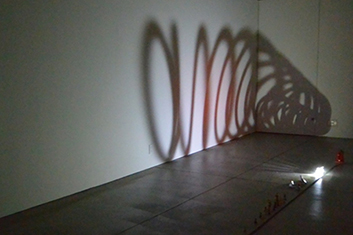 |
|
|
|
An ordinary piece of fruit exercises the imagination in if apple by Drawing and Manual. Lost #13 by Ryota Kuwakubo transforms household objects into an otherworldly terrain. Left photo courtesy of 21_21 Design Sight; right photo by Susan Rogers Chikuba
All photographs are by permission of 21_21 Design Sight.
|
Another work that provides a fresh way of looking at things is if apple by Drawing and Manual, the creative communications firm cofounded by Hishikawa. A series of anime shorts, it uses visual and sound effects to consider how an apple would respond to gravity if it were made of glass, wood, or rubber, or what an apple would behave like if it were a rocket, planet, or soccer ball. Popular with the younger set, this exhibit reminded me of the children's book Ringo kamo shirenai (It Might Be an Apple) by Shinsuke Yoshitake, a fanciful romp through the imagination of a young boy as he hungrily contemplates the fruit set on the table before him.
Also here is artist Ryota Kuwakubo, whose Lost #13 is the latest edition of his crowd-pleasing series of installations featuring the moving shadows cast by an LED-lit model train as it moves through a darkened landscape of bobbins, springs, rulers, chess pieces, and kitchenware.
Overall there's more poetry on display than science, but Hishikawa's ultimate goal isn't to leave viewers with some grand vision or aha moment. If anything, he aims to show how a simple, maybe even ineffectual, idea can be realized with a dose of curiosity, some knowledge of physical mechanisms, and a handful of familiar materials. Motion Science has less to do with the nuts and bolts of things than with remembering that nuts and bolts are there for us to build with, as we make our mark on the world around us.
 |
|
 |
 |
Susan Rogers Chikuba
Susan Rogers Chikuba, a Tokyo-based writer, editor and translator, has been following popular culture, architecture and design in Japan for three decades. She covers the country's travel, art, literary and culinary scenes for domestic and international publications. |
|
 |
|